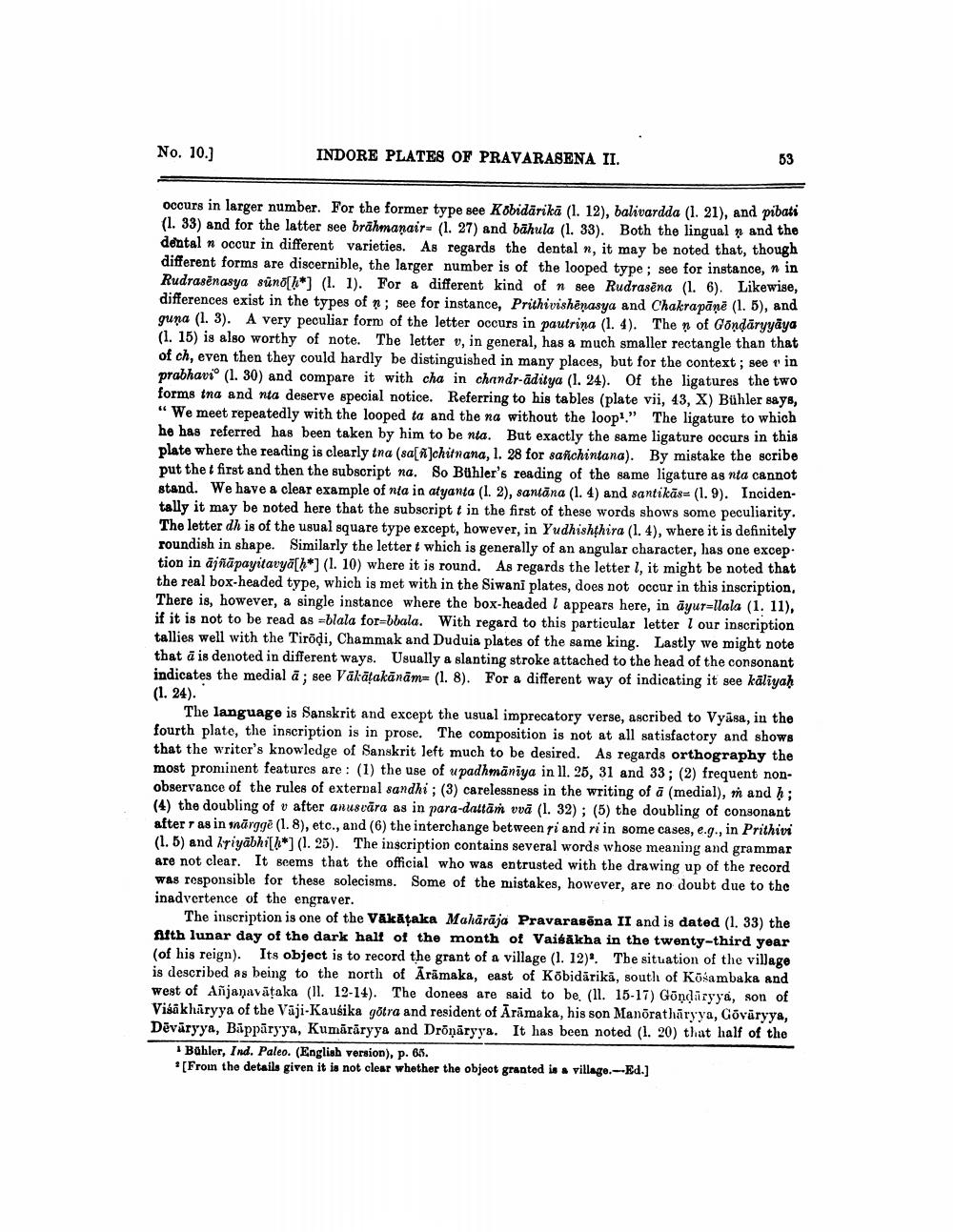________________
No. 10.)
INDORE PLATES OF PRAVARASENA II.
occurs in larger number. For the former type see Kobidarikā (1. 12), balivardda (1. 21), and pibati (1. 33) and for the latter see brāhmanair- (1. 27) and bāhula (1. 33). Both the lingual and the dental n occur in different varieties. As regards the dental n, it may be noted that, though different forms are discernible, the larger number is of the looped type; see for instance, n in Rudrasēnasya süno[h*] (1.1). For a different kind of n see Rudrasēna (1.6). Likewise, differences exist in the types of n; see for instance, Prithivishēnasya and Chakrapānē (1. 5), and guna (1. 3). A very peculiar form of the letter occurs in pautriņa (1. 4). Then of Göndāryyāya (1. 15) is also worthy of note. The letter v, in general, has a much smaller rectangle than that of ch, even then they could hardly be distinguished in many places, but for the context; see in prabhavi (1. 30) and compare it with cha in chandr-āditya (1. 24). Of the ligatures the two forms tna and nta deserve special notice. Referring to his tables (plate vii, 43, X) Bühler says, “We meet repeatedly with the looped ta and the na without the loop?." The ligature to which he has referred has been taken by him to be nta. But exactly the same ligature occurs in this plate where the reading is clearly tna (sa[n]chitnana, 1. 28 for sañchintana). By mistake the scribe put the t first and then the subscript na. So Bühler's reading of the same ligature as nta cannot stand. We have a clear example of nia in atyanta (1.2), santāna (1. 4) and santikās= (1.9). Incidentally it may be noted here that the subscript t in the first of these words shows some peculiarity. The letter dh is of the usual square type except, however, in Yudhishthira (1.4), where it is definitely roundish in shape. Similarly the letter t which is generally of an angular character, has one excep tion in ajñāpayitavyā[h*] (1. 10) where it is round. As regards the letter l, it might be noted that the real box-headed type, which is met with in the Siwani plates, does not occur in this inscription, There is, however, a single instance where the box-headed l appears here, in āyurullala (1. 11), if it is not to be read as =blala for=bbala. With regard to this particular letter l our inscription tallies well with the Tirodi, Chammak and Duduia plates of the same king. Lastly we might note that a is denoted in different ways. Usually a slanting stroke attached to the head of the consonant indicates the medial ā; see Vākāțakānām= (1. 8). For a different way of indicating it see kaliyah (1. 24).
The language is Sanskrit and except the usual imprecatory verse, ascribed to Vyasa, in the fourth plate, the inscription is in prose. The composition is not at all satisfactory and shows that the writer's knowledge of Sanskrit left much to be desired. As regards orthography the most prominent features are: (1) the use of u padhmāniya in 11. 25, 31 and 33; (2) frequent nonobservance of the rules of external sandhi ; (3) carelessness in the writing of a (medial), ń and h; (4) the doubling of v after anusvāra as in para-dattām uvā (1. 32); (5) the doubling of consonant after r as in sārgge (1.8), etc., and (6) the interchange between yi and ri in some cases, e.g., in Prithivi (1.5) and htiyābhi[l*] (1.25). The inscription contains several words whose meaning and grammar are not clear. It seems that the official who was entrusted with the drawing up of the record was responsible for these solecisms. Some of the mistakes, however, are no doubt due to the inadvertence of the engraver.
The inscription is one of the Vakātaka Mahārāja Pravarasēna II and is dated (1. 33) the Afth lunar day of the dark half of the month of Vaišākha in the twenty-third year (of his reign). Its object is to record the grant of a village (1. 12). The situation of the village is described as being to the north of Ārāmaka, east of Köbidárika, south of Kosambaka and west of Añjanavāțaka (II. 12-14). The donees are said to be. (11. 15-17) Göndaryya, son of Visakhāryya of the Vaji-Kausika gotra and resident of Ārāmaka, his son Manorathāryya, Goväryya, Dēväryya, Bäppäryya, Kumārāryya and Drõņāryya. It has been noted (1. 20) that half of the
Bühler, Ind. Paleo. (English version), p. 6.8. [From the details given it is not clear whether the objeot granted is a villago.--Ed.]




